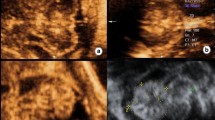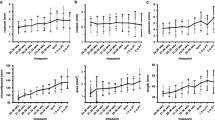Abstract
Objective
The definition of new normal values of the corpus callosum (CC) in axial sonographic scans and evaluation of their feasibility in diagnosing abnormal CC.
Methods
A cross-sectional study assessed CC from 20-gestational-week to full-term. CC observations across three axial planes (the largest CC length plane, trans-genu-and-splenium plane, and trans-body plane) were developed. The largest CC length, genu and splenium thickness, and body width and thickness were compared with compound scatter plots. Ultrasonographic features of normal and abnormal CC were described and the feasibility of the new approach studied. Intra-class correlation coefficient (ICC) was used for assessing the intra- and inter-observer agreements.
Results
Six hundred seventy normal and 42 abnormal fetuses from 20-gestational-week to full-term were studied. The mean normal and abnormal group maternal ages were 30.46 ± 4.36 years and 29.69 ± 4.49 years (p = 0.269). The success rate in obtaining satisfactory axial planes reached 100% but only 13.9% for sagittal plane in the normal group. The success rate of abnormal cases obtaining satisfactory axial planes was 100% and 59.5% by sagittal plane (p < 0.05). The compound scatter plots of abnormal and normal groups showed that the largest CC length and body width were significantly lower in normal fetuses, and the thickness of the genu and splenium with CC hypoplasia was significantly lower than normal fetuses. The intra- and inter-observer agreements were reproducible (all ICC > 0.850).
Conclusions
The feasibility of incorporating an evaluation of CC into routine anatomical screening was demonstrated. Additionally, a focused examination of the craniocerebral axial planes exploring CC at the time of central nervous system scanning might facilitate CC anomaly detection.
Key Points
• Three axial planes with direct CC measurements can detect CC anomalies more accurately compared with indirect CC signs. Besides, this method is simpler, more convenient, and time-saving compared with the sagittal plane.
• Assessing fetal CC on the axial plane helps clinicians to diagnose fetuses with abnormal CC.
• A prospective single-center study showed that our new technique provides enough diagnostic confidence.






Similar content being viewed by others
Abbreviations
- BCC:
-
Body of the CC
- BLV:
-
Lateral ventricle
- CACC:
-
Complete agenesis of the corpus callosum
- CC:
-
Corpus callosum
- CMA:
-
Chromosome microarray
- CSP:
-
Cavum septum pellucid
- FC:
-
Falx cerebra
- GCC:
-
Genu of the CC
- HpCC:
-
Hypoplasia of the corpus callosum
- PACC:
-
Partial agenesis of the corpus callosum
- SCC:
-
Splenium of the CC
- TCN:
-
The caudate nucleus
- TLV:
-
The lateral ventricle
- WC:
-
Wechsler cavity
References
Hinkley LB, Marco EJ, Findlay AM et al (2012) The role of corpus callosum development in functional connectivity and cognitive processing. PLoS ONE 7:e39804
Paul LK, Brown WS, Adolphs R et al (2007) Agenesis of the corpus callosum: genetic, developmental and functional aspects of connectivity. Nat Rev Neurosci 8:287–299
Grogono JL (1968) Children with agenesis of the corpus callosum. Dev Med Child Neurol 10:613–616
Jeret JS, Serur D, Wisniewski KE, Lubin RA (1987) Clinicopathological findings associated with agenesis of the corpus callosum. Brain Dev 9:255–264
Malinger G, Zakut H (1993) The corpus callosum: normal fetal development as shown by transvaginal sonography. AJR Am J Roentgenol 161:1041–1043
Achiron R, Achiron A (2001) Development of the human fetal corpus callosum: a high-resolution, cross-sectional sonographic study. Ultrasound Obstet Gynecol 18:343–347
Monteagudo A, Timor-Tritsch IE (2009) Normal sonographic development of the central nervous system from the second trimester onwards using 2D, 3D and transvaginal sonography. Prenat Diagn 29:326–339
Zhang HC, Yang J, Chen ZP, Ma XY (2009) Sonographic study of the development of fetal corpus callosum in a Chinese population. J Clin Ultrasound 37:75–77
Miguelote RF, Vides B, Santos RF, Palha JA, Matias A, Sousa N (2011) The role of three-dimensional imaging reconstruction to measure the corpus callosum: comparison with direct mid-sagittal views. Prenat Diagn 31:875–880
Miguelote RF, Vides B, Santos RF, Matias A, Sousa N (2012) Feasibility and reproducibility of transvaginal, transabdominal, and 3D volume reconstruction sonography for measurement of the corpus callosum at different gestational ages. Fetal Diagn Ther 31:19–25
Li WY (2014) To summarize the indirect ultrasound characteristics of absent corpus callosum and to explore a new approach for screening fetal absent of corpus callosum at 11-13 + 6 weeks. Dissertation of the master degree. Faculty of Medicine, Southern Medical University, China
Malinger G, Lerman-Sagie T, Viñals F (2006) Three-dimensional sagittal reconstruction of the corpus callosum: fact or artifact? Ultrasound Obstet Gynecol 28:742–743
International Society of Ultrasound in Obstetrics & Gynecology Education Committee (2007) Sonographic examination of the fetal central nervous system: guidelines for performing the ‘basic examination’ and the ‘fetal neurosonogram’. Ultrasound Obstet Gynecol 29:109–116
Barkovich AJ, Lyon G, Evrard P (1992) Formation, maturation, and disorders of white matter. AJNR Am J Neuroradiol 13:447–461
Pilu G, Sandri F, Perolo A et al (1993) Sonography of fetal agenesis of the corpus callosum: a survey of 35 cases. Ultrasound Obstet Gynecol 3:318–329
Bornstein E, Monteagudo A, Santos R, Keeler SM, Timor-Tritsch IE (2010) A systematic technique using 3-dimensional ultrasound provides a simple and reproducible mode to evaluate the corpus callosum. Am J Obstet Gynecol 202(201):e1–e5
Rizzo G, Capponi A, Pietrolucci ME et al (2011) An algorithm based on OmniView technology to reconstruct sagittal and coronal planes of the fetal brain from volume datasets acquired by three-dimensional ultrasound. Ultrasound Obstet Gynecol 38:158–164
Frisova V, Srutova M, Hyett J (2018) 3-D volume assessment of the corpus callosum and cerebellar vermis using various volume acquisition and post-processing protocols. Fetal Diagn Ther 43:199–207
Barkovich AJ, Norman D (1988) Anomalies of the corpus callosum: correlation with further anomalies of the brain. AJR Am J Roentgenol 151:171–179
Acknowledgments
This study has received funding by The National Key Research and Development Program of China (2018YFC1002202), the National Nature Science Foundation of China (81771598), and Shenzhen Science and Technology project (JCYJ20170307091013214).
Funding
This study has received funding by The National Key Research and Development Program of China (2018YFC1002202), the National Nature Science Foundation of China (81771598), and Shenzhen Science and Technology project (JCYJ20170307091013214).
Author information
Authors and Affiliations
Corresponding author
Ethics declarations
Guarantor
The scientific guarantor of this publication is Prof. Shengli Li.
Conflict of interest
The authors of this manuscript declare no relationships with any companies.
Statistics and biometry
No complex statistical methods were necessary for this paper.
Informed consent
Written informed consent was obtained from all subjects (patients) in this study.
Ethical approval
Institutional Review Board approval was obtained.
Methodology
• cross-sectional study
• performed at one institution
Additional information
Publisher’s note
Springer Nature remains neutral with regard to jurisdictional claims in published maps and institutional affiliations.
Rights and permissions
About this article
Cite this article
Zeng, Q., Wen, H., Yuan, Y. et al. A novel technique to assess fetal corpus callosum by two-dimensional axial plane. Eur Radiol 30, 5871–5880 (2020). https://doi.org/10.1007/s00330-020-06981-9
Received:
Revised:
Accepted:
Published:
Issue Date:
DOI: https://doi.org/10.1007/s00330-020-06981-9




